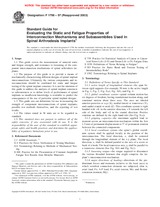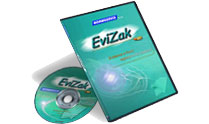Potřebujeme váš souhlas k využití jednotlivých dat, aby se vám mimo jiné mohly ukazovat informace týkající se vašich zájmů. Souhlas udělíte kliknutím na tlačítko „OK“.
ASTM F1798-97(2003)
Standard Guide for Evaluating the Static and Fatigue Properties of Interconnection Mechanisms and Subassemblies Used in Spinal Arthrodesis Implants
Automaticky přeložený název:
Standardní Příručka pro hodnocení statické a únavové vlastnosti propojovacích mechanismů a podsestav použitých v spinální implantáty artrodéza
NORMA vydána dne 1.11.2003
Informace o normě:
Označení normy: ASTM F1798-97(2003)
Poznámka: NEPLATNÁ
Datum vydání normy: 1.11.2003
Kód zboží: NS-51602
Počet stran: 10
Přibližná hmotnost: 30 g (0.07 liber)
Země: Americká technická norma
Kategorie: Technické normy ASTM
Anotace textu normy ASTM F1798-97(2003) :
Keywords:
gripping capacity, interconnection, run out, spinal arthrodesis implant, subassembly, ICS Number Code 11.040.40 (Implants for surgery, prothetics and orthotics)
Doplňující informace
| Significance and Use | ||||||
|
Spinal implants are generally composed of several components that, when connected together, form a spinal implant construct. Spinal implant constructs are designed to provide some stability to the spine while arthrodesis takes place. This guide outlines standardized evaluations of different interconnection mechanisms so that comparison between different designs is facilitated. Comparisons must be made cautiously and with careful analysis, taking into account the effects that design differences can have on the loading configurations. This guide is used to quantify the static and fatigue properties of different implant interconnection designs. The mechanical tests are conducted in vitro using simplified, unidirectional loads and moments. Fatigue testing in a simulated body fluid or saline may have a fretting, corrosive, or lubrication effect on the interconnection and thereby affect the relative performance of tested devices. Hence, the test environment, whether a simulated body fluid, saline (9g NaCl per 1000 mL H2O), with a saline drip, or dry, is an important characteristic of the test and must be reported accurately. The loading of spinal implant constructs in vivo will, in general, differ from the loading configurations used in this guide. The results obtained here cannot be used directly to predict in vivo performance. However, the results can be used to compare different component designs in terms of relative mechanical parameters. |
||||||
| 1. Scope | ||||||
|
1.1 This guide covers the measurement of uniaxial static and fatigue strength, and resistance to loosening of the component interconnection mechanisms of spinal arthrodesis implants. 1.2 The purpose of this guide is to provide a means of mechanically characterizing different designs of spinal implant interconnections. Ultimately, the various components and interconnections should be combined for static and fatigue testing of the spinal implant construct. It is not the intention of this guide to address the analysis of spinal implant constructs or subconstructs or to define levels of performance of spinal implants as insufficient knowledge is available to predict the consequences of the use of particular spinal implant designs. 1.3 This guide sets out definitions for use in measuring the strength of component interconnections of spinal implants, possible test methods themselves, and the reporting of test results. 1.4 The values stated in SI units are to be regarded as standard. 1.5 This standard does not purport to address all of the safety concerns, if any, associated with its use. It is the responsibility of the user of this standard to establish appropriate safety and health practices and determine the applicability of regulatory limitations prior to use. |
||||||
| 2. Referenced Documents | ||||||
|
Doporučujeme:
EviZak - všechny zákony včetně jejich evidence na jednom místě
Poskytování aktuálních informací o legislativních předpisech vyhlášených ve Sbírce zákonů od roku 1945.
Aktualizace 2x v měsíci !
Chcete vědět více informací? Podívejte se na tuto stránku.




 Cookies
Cookies
